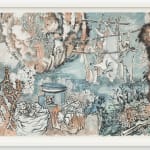

Drought in Village Wen, 2013
Watercolor on Xuan paper and silk
13 5/8 x 40 1/2 in
34.5 x 103 cm
34.5 x 103 cm
$ 28,000.00
Yun-Fei Ji employs the stacked perspective and flattened space of classical Chinese painting to tell contemporary stories that, while geographically specific, speak to a collective human experience. Drought in Village...
Yun-Fei Ji employs the stacked perspective and flattened space of classical Chinese painting to tell contemporary stories that, while geographically specific, speak to a collective human experience. Drought in Village Wen belongs to a series of works by Ji that relay the story of a fictional rural village being displaced by the intertwined forces of Chinese government policy and ecological disaster. For Ji, calligraphic inscription provides context and historical depth to the imagery in his ink and watercolor paintings, allowing him to craft metaphor-rich narratives that speak to the social and psychological anxieties of the world today.
The inscription reads:
"According to the elders in Village Wen, many villagers starved to death during the Great Leap Forward. People could hear the ghosts’ cries along the roads around the village even during the daytime. Villagers were afraid of leaving their homes. Then someone said that anyone would be scared of the village secretary—including the ghosts—if you said his name loudly enough. This solution proved effective.
Some people in Village Wen were not willing to immigrate to cities for work. They farmed fish and worked in the fields. There was a big drought in Year Xin Mao. Upstream, there was not enough water for the farming of fish, so the villagers had to pull the fish cages tens of miles downstream. In June, it began raining nonstop and the river’s water level soared. The fish, which the villagers had been cultivating for three years, all suddenly died."
- Yun-Fei Ji, translated 2013
The inscription reads:
"According to the elders in Village Wen, many villagers starved to death during the Great Leap Forward. People could hear the ghosts’ cries along the roads around the village even during the daytime. Villagers were afraid of leaving their homes. Then someone said that anyone would be scared of the village secretary—including the ghosts—if you said his name loudly enough. This solution proved effective.
Some people in Village Wen were not willing to immigrate to cities for work. They farmed fish and worked in the fields. There was a big drought in Year Xin Mao. Upstream, there was not enough water for the farming of fish, so the villagers had to pull the fish cages tens of miles downstream. In June, it began raining nonstop and the river’s water level soared. The fish, which the villagers had been cultivating for three years, all suddenly died."
- Yun-Fei Ji, translated 2013

